General Overview of Antennas for Unmanned Aerial Vehicles: A Review
Abstract
1. Introduction
2. Single-Element Antennas Used in UAVs
2.1. Dipole
2.2. Monopole
2.3. Horn, Vivaldi, and DR
2.4. Microstrip Patch
3. Comparative Analysis
3.1. Type of Antennas
3.2. Frequency, Bandwidth, and Applications
3.3. Polarization
3.4. Size and Weight
3.5. Fabricated Antennas, Used UAVs, and Applications
4. Miniaturization Techniques
4.1. Techniques That Modify Antennas’ Physical Structure
4.2. Material-Based Techniques That Change the Electromagnetic Properties of an Antenna
5. Multi-Antenna Systems
5.1. Beam-Switching
5.2. Beam-Steering
5.3. Beam-Scanning
5.4. Metasurfaces
5.5. Array
6. Discussion
7. Emerging Trends and Future Directions
8. Conclusions
Author Contributions
Funding
Conflicts of Interest
References
- Criollo, L.; Mena-Arciniega, C.; Xing, S. Classification, military applications, and opportunities of unmanned aerial vehicles. Aviation 2024, 28, 115–127. [Google Scholar] [CrossRef]
- Hall, O.; Wahab, I. The Use of Drones in the Spatial Social Sciences. Drones 2021, 5, 112. [Google Scholar] [CrossRef]
- Yafoz, A. Drones in Action: A Comprehensive Analysis of Drone-Based Monitoring Technologies. Data Metadata 2024, 3, 364. [Google Scholar] [CrossRef]
- Mahfuz, M.M.H.; Park, C.W. Review of Patch Antennas used in Drone Applications. IEEE Access 2023, 11, 58367–58388. [Google Scholar] [CrossRef]
- Fixed Wing UAV Drone Free 3D Model. Available online: https://www.cgtrader.com/items/4453704/download-page (accessed on 29 June 2025).
- Vallikannu, R.; Sankar, P.; Kavitha, B.; Vinoth, M. Flexible And Improved Antennae For Drone Applications. In Proceedings of the 2024 Third International Conference on Electrical, Electronics, Information and Communication Technologies (ICEEICT), Trichirappalli, India, 24–26 July 2024; IEEE: Piscataway, NJ, USA, 2024; pp. 1–5. [Google Scholar] [CrossRef]
- Saeidi, T.; Saleh, S.; Timmons, N.; Al-Gburi, A.J.A.; Karamzadeh, S.; Althuwayb, A.A.; Rashid, N.; Kaaniche, K.; Ben Atitallah, A.; Elhamrawy, O.I. Meta Surface-Based Multiband MIMO Antenna for UAV Communications at mm-Wave and Sub-THz Bands. Drones 2024, 8, 403. [Google Scholar] [CrossRef]
- Hehenberger, S.P.; Elmarissi, W.; Caizzone, S. Design and Installed Performance Analysis of a Miniaturized All-GNSS Bands Antenna Array for Robust Navigation on UAV Platforms. Sensors 2022, 22, 9645. [Google Scholar] [CrossRef]
- Akhter, Z.; Bilal, R.M.; Shamim, A. A Dual Mode, Thin and Wideband MIMO Antenna System for Seamless Integration on UAV. IEEE Open J. Antennas Propag. 2021, 2, 991–1000. [Google Scholar] [CrossRef]
- Škiljo, M.; Udženija, M.; Blažević, Z. Axial Ratio of Quarter- and Half-wavelength Cloverleaf Antenna for Drone FPV Applications. In Proceedings of the 2023 International Conference on Software, Telecommunications and Computer Networks (SoftCOM), Split, Croatia, 21–23 September 2023; IEEE: Piscataway, NJ, USA, 2023; pp. 1–5. [Google Scholar] [CrossRef]
- Fallahpour, M.; Zoughi, R. Antenna Miniaturization Techniques: A Review of Topology- and Material-Based Methods. IEEE Antennas Propag. Mag. 2018, 60, 38–50. [Google Scholar] [CrossRef]
- Hoque, M.U.; Kumar, D.; Audet, Y.; Savaria, Y. Design and Analysis of a 35 GHz Rectenna System for Wireless Power Transfer to an Unmanned Air Vehicle. Energies 2022, 15, 320. [Google Scholar] [CrossRef]
- Das, D.; Hossain, M.A.; Rahman, M.A. Circularly Polarized Single Layer Large Scale Microstrip Patch Array Antenna for Wireless Communications. In Proceedings of the 2024 3rd International Conference on Advancement in Electrical and Electronic Engineering (ICAEEE), Gazipur, Bangladesh, 25–27 April 2024; IEEE: Piscataway, NJ, USA, 2024; pp. 1–6. [Google Scholar] [CrossRef]
- Sidorov, I.; Gudkov, A.; Novichickin, E.; Chizhikov, S. Bipolarized S and L Band Radiometer for Remote Sensing. In Proceedings of the 2024 International Conference on Actual Problems of Electron Devices Engineering (APEDE), Saratov, Russia, 26–27 September 2024; IEEE: Piscataway, NJ, USA, 2024; pp. 73–76. [Google Scholar] [CrossRef]
- Furse, C.M.; Gandhi, O.P.; Lazzi, G. Dipole Antennas. In Wiley Encyclopedia of Electrical and Electronics Engineering; John Wiley & Sons, Inc.: New York, NY, USA, 2007. [Google Scholar] [CrossRef]
- Singh, S.; Chakareski, J. Aerial 360-Degree Video Delivery for Immersive First Person View UAV Navigation. In Proceedings of the 2023 IEEE International Symposium on Multimedia (ISM), Laguna Hills, CA, USA, 11–13 December 2023; IEEE: Piscataway, NJ, USA, 2023; pp. 139–146. [Google Scholar] [CrossRef]
- Lee, H.; Kim, Y.B.; Lee, H.L. Reconfigurable Antenna for UAV-Assisted Wide Coverage Air-to-Ground Communications. IEEE Access 2022, 10, 88034–88042. [Google Scholar] [CrossRef]
- Safaron, M.S.; Majid, H.A.; Esmail, B.A.F.; Ghafar, A.S.A.; Safarudin, F.A.; Ismail, M.F.; Zubir, F.; Abdullah, M.A. Directional cloverleaf antenna for unmanned aerial vehicle (UAV) application. Indonesian Journal of Electrical Engineering and Computer Science 2019, 14, 773–779. [Google Scholar] [CrossRef]
- Jeong, Y.Y.; Lee, W.S. Wideband Printed Half Bow-Tie Antenna Array Based on a Quad-Mode Reconfigurable Feeding Network for UAV Communications. IEEE Open J. Antennas Propag. 2021, 2, 238–248. [Google Scholar] [CrossRef]
- Kim, K.S.; Yoo, J.S.; Kim, J.W.; Kim, S.; Yu, J.W.; Lee, H.L. All-Around Beam Switched Antenna With Dual Polarization for Drone Communications. IEEE Trans. Antennas Propag. 2020, 68, 4930–4934. [Google Scholar] [CrossRef]
- Park, J.S.; Kim, M.S.; Lee, W.S. Miniaturized UHF Module-Integrated Antenna With RF-Based Detection for Multi-Objective UAV Applications. In Proceedings of the 2022 International Symposium on Antennas and Propagation (ISAP), Sydney, Australia, 31 October–3 November 2022; IEEE: Piscataway, NJ, USA, 2022; pp. 321–322. [Google Scholar] [CrossRef]
- Milias, C.; Andersen, R.B.; Jørgensen, T.H.; Lazaridis, P.I.; Zaharis, Z.D.; Muhammad, B.; Kristensen, J.T.B.; Mihovska, A.; Hermansen, D.D.S. Metasurface-based, Pattern-reconfigurable, Wide-angle Scanning Antenna Array for UAV-borne Radar. In Proceedings of the 2023 IEEE Radar Conference (RadarConf23), San Antonio, TX, USA, 1–5 May 2023; IEEE: Piscataway, NJ, USA, 2023; pp. 1–6. [Google Scholar] [CrossRef]
- Peng, J.J.; Qu, S.W.; Xia, M.; Yang, S. Conformal Phased Array Antenna for Unmanned Aerial Vehicle With ±70° Scanning Range. IEEE Trans. Antennas Propag. 2021, 69, 4580–4587. [Google Scholar] [CrossRef]
- Balanis, C.A. Antenna Theory, 1st ed.; New York Academy of Sciences Series; John Wiley & Sons Inc.: Newark, NJ, USA, 2016. [Google Scholar]
- Yang, Y.; Kwon, D.H. Indirect impedance measurement of a small dipole antenna over a ground plane. In Proceedings of the 2017 International Workshop on Antenna Technology: Small Antennas, Innovative Structures, and Applications (iWAT), Athens, Greece, 1–3 March 2017; IEEE: Piscataway, NJ, USA, 2017; pp. 203–206. [Google Scholar] [CrossRef]
- Kamesh, M.; Ganesh, S.K.; Kushal, G.G.; Sai, K. Design a Quarter-wave monopole antenna specifically designed for Wireless internet applications at 2.4 GHz. In Proceedings of the 2024 10th International Conference on Communication and Signal Processing (ICCSP), Melmaruvathur, India, 12–14 April 2024; IEEE: Piscataway, NJ, USA, 2024; pp. 943–946. [Google Scholar] [CrossRef]
- Choi, Y.S.; Lee, W.S. Reconfigurable Beam Switching Antenna With Horizontal Parasitic Element Reflector (HPER) for UAV Applications. In Proceedings of the 2020 IEEE International Symposium on Antennas and Propagation and North American Radio Science Meeting, Montreal, QC, Canada, 5–10 July 2020; IEEE: Piscataway, NJ, USA, 2020; pp. 433–434. [Google Scholar] [CrossRef]
- Choi, Y.S.; Park, J.S.; Lee, W.S. Beam-Reconfigurable Multi-Antenna System with Beam-Combining Technology for UAV-to-Everything Communications. Electronics 2020, 9, 980. [Google Scholar] [CrossRef]
- Pednekar, A.A.; Lingam, B.S.; Nigil, M.R.; Rahul Raja, R.; Sabarish Narayanan, B. Low Footprint Meander Monopole Patch As EMI Sensors. In Proceedings of the 2024 IEEE Applied Sensing Conference (APSCON), Goa, India, 22–24 January 2024; IEEE: Piscataway, NJ, USA, 2024; pp. 1–4. [Google Scholar] [CrossRef]
- Tang, X.; Zhao, X.; Zhou, H.; Geng, J.; Lu, J.; Zhao, R.; Li, X.; Li, E.; Liu, H.; He, C.; et al. Large FoV Direction-Finding System Based on A Small-Aperture Phase Mode Antenna and Its Applications on UAVs. IEEE Internet Things J. 2025, 12, 3076–3088. [Google Scholar] [CrossRef]
- Sheng, G.; Jian, S.W.; Yu, Z.; You, L.C. Design Method OF RF Frontend Based on Interferometer Direction Finding Technology. In Proceedings of the 2023 5th International Conference on Circuits and Systems (ICCS), Huzhou, China, 27–30 October 2023; IEEE: Piscataway, NJ, USA, 2023; pp. 104–107. [Google Scholar] [CrossRef]
- van Rooyen, M.; Odendaal, J.W.; Joubert, J. High-Gain Directional Antenna for WLAN and WiMAX Applications. IEEE Antennas Wirel. Propag. Lett. 2017, 16, 286–289. [Google Scholar] [CrossRef]
- Carpenter, A.; Lawrence, J.A.; Ghail, R.; Mason, P.J. The Development of Copper Clad Laminate Horn Antennas for Drone Interferometric Synthetic Aperture Radar. Drones 2023, 7, 215. [Google Scholar] [CrossRef]
- Carpenter, A.; Lawrence, J.A.; Mason, P.J.; Ghail, R.; Agar, S. Drone SAR Imaging for Monitoring an Active Landslide Adjacent to the M25 at Flint Hall Farm. Remote Sens. 2024, 16, 3874. [Google Scholar] [CrossRef]
- Lahiry, A.; Le, K.N.; Bao, V.N.Q.; Vivian Tam, W. Endurance Enhancement of Aerial Vehicle Energy Transmitters Using Conical Corrugated Horn Antenna. In Proceedings of the 2023 28th Asia Pacific Conference on Communications (APCC), Sydney, Australia, 19–22 November 2023; IEEE: Piscataway, NJ, USA, 2023; pp. 273–278. [Google Scholar] [CrossRef]
- Pi, C. A Ultra High Frequency Miniaturized Wideband Vivaldi Antenna Design. In Proceedings of the 2024 3rd International Symposium on Semiconductor and Electronic Technology (ISSET), Xi’an, China, 23–25 August 2024; IEEE: Piscataway, NJ, USA, 2024; pp. 162–166. [Google Scholar] [CrossRef]
- Amador, M.; Rouco, A.; Albuquerque, D.; Pinho, P. Overview of Vivaldi Antenna Selection for Through-Wall Radar Applications. Sensors 2024, 24, 6536. [Google Scholar] [CrossRef] [PubMed]
- Zarrabi, F.B.; Gandji, N.P.; Ahmadian, R.; Kuhestani, H.; Mansouri, Z. Modification of Vivaldi Antenna for 2–18 GHz UWB Application with Substrate Integration Waveguide Structure and Comb Slots. Appl. Comput. Electromagn. Soc. J. 2015, 30, 844–849. [Google Scholar]
- García Fernández, M.; Álvarez Narciandi, G.; Arboleya, A.; Vázquez Antuña, C.; Andrés, F.L.H.; Álvarez López, Y. Development of an Airborne-Based GPR System for Landmine and IED Detection: Antenna Analysis and Intercomparison. IEEE Access 2021, 9, 127382–127396. [Google Scholar] [CrossRef]
- Soren, D.; Ghatak, R.; Mishra, R.K.; Poddar, D.R. Dielectric Resonator Antennas: Designs and Advances. Prog. Electromagn. Res. B 2014, 60, 195–213. [Google Scholar] [CrossRef]
- Haxhi, A.; Orfanos, M.; Perakis, H.; Gikas, V. Addressing the Potential of L5/E5a Signals for Road ITS Applications in GNSS-Harsh Environments. Eng. Proc. 2023, 54, 11. [Google Scholar] [CrossRef]
- Zavosh, F.; Aberle, J. Improving the performance of microstrip-patch antennas. IEEE Antennas Propag. Mag. 1996, 38, 7–12. [Google Scholar] [CrossRef]
- Pradhan, S.; Gupta, B. High-Gain Dual-Mode Cylindrical Rectangular Patch Antenna for Airborne Applications. IEEE Trans. Aerosp. Electron. Syst. 2022, 58, 4168–4179. [Google Scholar] [CrossRef]
- Zarbakhsh, S.; Sebak, A.R. Multifunctional Drone-Based Antenna for Satellite Communication. IEEE Trans. Antennas Propag. 2022, 70, 7223–7227. [Google Scholar] [CrossRef]
- Dominguez, B.; Silva, F.; Baghel, A.; Albuquerque, D.; Pinho, P. Optically Transparent Antennas for 5G and Beyond: A Review. Electronics 2025, 14. [Google Scholar] [CrossRef]
- Seo, D.G.; Kim, J.H.; Tentzeris, M.M.; Lee, W.S. A Quadruple-Polarization Reconfigurable Feeding Network for UAV RF Sensing Antenna. IEEE Microw. Wirel. Components Lett. 2019, 29, 183–185. [Google Scholar] [CrossRef]
- Lu, Y.; Jia, J.; He, W. Design of Ka-Band Tree-Shaped Fractal Millimeter Wave Antenna. In Proceedings of the 2022 IEEE 5th International Conference on Electronics and Communication Engineering (ICECE), Xi’an, China, 16–18 December 2022; IEEE: Piscataway, NJ, USA, 2022; pp. 131–134. [Google Scholar] [CrossRef]
- Qin, Y.; Han, M.; Zhang, L.; Mao, C.X.; Zhu, H. A Compact Dual-Band Omnidirectional Circularly Polarized Filtering Antenna for UAV Communications. IEEE Trans. Veh. Technol. 2023, 72, 16742–16747. [Google Scholar] [CrossRef]
- Nasimuddin.; Chia, M.Y. Metasurface with Unequal Spacing Unit-cells based Antenna for Linear and Circular Polarizations. In Proceedings of the 2023 17th European Conference on Antennas and Propagation (EuCAP), Florence, Italy, 26–31 March 2023; IEEE: Piscataway, NJ, USA, 2023. [Google Scholar] [CrossRef]
- Reyna, A.; Garza, J.C.; Balderas, L.I.; Méndez, J.; Panduro, M.A.; Maldonado, G.; García, L.Y. Virtual Antenna Arrays with Frequency Diversity for Radar Systems in Fifth-Generation Flying Ad Hoc Networks. Appl. Sci. 2024, 14, 4219. [Google Scholar] [CrossRef]
- Mandal, P.; Kashyap, C.S.; Roy, L.P.; Das, S.K. Reconfigurable Radar Antenna Design for UAV Application. In Proceedings of the 2023 International Conference for Advancement in Technology (ICONAT), Goa, India, 24–26 January 2023; IEEE: Piscataway, NJ, USA, 2023; pp. 1–6. [Google Scholar] [CrossRef]
- Patwary, A.B.; Mahbub, I. 4×4 UWB Phased Array Antenna With >51° Far-Field Scanning Range for Wireless Power Transfer Application. IEEE Open J. Antennas Propag. 2024, 5, 354–367. [Google Scholar] [CrossRef]
- Kashihara, H.; Sumantyo, J.T.S.; Izumi, Y.; Ito, K.; Gao, S.; Namba, K. X-Band Microstrip Array Antenna for UAV Onboard Full Circularly Polarized Synthetic Aperture Radar. IEEE Trans. Antennas Propag. 2023, 71, 1943–1948. [Google Scholar] [CrossRef]
- Cinar, A.O.; Uzer, D.; Gultekin, S.S. Circular Microstrip Antenna Array at 5.8 GHz Frequency for Unmanned Aerial Vehicles. In Proceedings of the 2021 International Conference on Electromagnetics in Advanced Applications (ICEAA), Honolulu, HI, USA, 9–13 August 2021; IEEE: Piscataway, NJ, USA, 2021; p. 93. [Google Scholar] [CrossRef]
- Yusuf, A.M.; Wijanto, H.; Edwar. Dual C-X-Band E-Shaped Microstrip Antenna Array 1 × 8 for Synthetic Aperture Radar on UAV. In Proceedings of the 2019 IEEE International Conference on Signals and Systems (ICSigSys), Bandung, Indonesia, 16–18 July 2019; IEEE: Piscataway, NJ, USA, 2019; pp. 186–189. [Google Scholar] [CrossRef]
- Nachev, I.; Iliev, I.; Ilieva, A.; Valkovski, T. Model of Scanning Antenna Array with UAV Navigation and OATR Monitoring Applications. In Proceedings of the 2024 59th International Scientific Conference on Information, Communication and Energy Systems and Technologies (ICEST), Sozopol, Bulgaria, 1–3 July 2024; IEEE: Piscataway, NJ, USA, 2024; pp. 1–4. [Google Scholar] [CrossRef]
- Suratman, M.; Mansor, M. Development of GPS Receive Antenna with Anti-Jamming Capabilities. In Proceedings of the 2024 IEEE 7th International Symposium on Telecommunication Technologies (ISTT), Langkawi Island, Malaysia, 21–22 October 2024; IEEE: Piscataway, NJ, USA, 2024; pp. 162–165. [Google Scholar] [CrossRef]
- Bories, S.; Allabouche, K.; Daniele, N. Recent Development on Search of Avalanches Victims with Monopulse Antenna mounted on a small UAV. In Proceedings of the 2019 13th European Conference on Antennas and Propagation (EuCAP), Krakow, Poland, 31 March–5 April 2019; IEEE: Piscataway, NJ, USA, 2019; pp. 1–6. [Google Scholar]
- Kashihara, H.; Sumantyo, J.T.S. Development of X-band microstrip antenna for circularly polarized synthetic aperture radar onboard UAV. In Proceedings of the 2021 7th Asia-Pacific Conference on Synthetic Aperture Radar (APSAR), Bali, Indonesia, 1–3 November 2021; IEEE: Piscataway, NJ, USA, 2021; pp. 1–4. [Google Scholar] [CrossRef]
- Shearwood, J.; Aldabashi, N.; Eltokhy, A.; Franklin, E.L.; Raine, N.E.; Zhang, C.; Palmer, E.; Cross, P.; Palego, C. C-Band Telemetry of Insect Pollinators Using a Miniature Transmitter and a Self-Piloted Drone. IEEE Trans. Microw. Theory Tech. 2021, 69, 938–946. [Google Scholar] [CrossRef]
- Arana-Pulido, V.; Jimenez-Yguacel, E.; Cabrera-Almeida, F.; Quintana-Morales, P. Antenna System for Trilateral Drone Precise Vertical Landing. IEEE Trans. Instrum. Meas. 2022, 71, 3000508. [Google Scholar] [CrossRef]
- Kumar, R.; Kartikeyan, M. Design and Development of Wideband Radiating Array for Airborne LOS Communication System. In Proceedings of the 2019 IEEE Indian Conference on Antennas and Propogation (InCAP), Ahmedabad, India, 19–22 December 2019; IEEE: Piscataway, NJ, USA, 2019; pp. 1–4. [Google Scholar] [CrossRef]
- Akashkin, E.L.; Matveev, V.S.; Kuzmin, I.A.; Tsvetkov, V.K.; Meleshin, Y.M.; Lyalin, K.S. Multi-Band Compact Microstrip Antenna. In Proceedings of the 2022 IEEE International Multi-Conference on Engineering, Computer and Information Sciences (SIBIRCON), Yekaterinburg, Russia, 11–13 November 2022; IEEE: Piscataway, NJ, USA, 2022; pp. 1210–1214. [Google Scholar] [CrossRef]
- Byeon, K.; Seo, B.J.; Park, D.; Jung, G.; Jang, W.; Eo, Y.S. A 24 GHz Antenna Embedded Radar Sensor Using UWB Radar SoC. In Proceedings of the 2022 Asia-Pacific Microwave Conference (APMC), Yokohama, Japan, 29 November–2 December 2022; IEEE: Piscataway, NJ, USA, 2022; pp. 234–236. [Google Scholar] [CrossRef]
- Peng, Y.; Wang, X.H.; Hu, J.J.; Xu, Y.; Shi, X.W. Design of Miniature Millimeter Wave Radar System Based on TI Integrated Chip. In Proceedings of the 2022 International Conference on Microwave and Millimeter Wave Technology (ICMMT), Harbin, China, 12–15 August 2022; IEEE: Piscataway, NJ, USA, 2022; pp. 1–3. [Google Scholar] [CrossRef]
- Dreissigacker, M.; Müller, F.; Tschoban, C.; Perlwitz, P.; Becker, K.F.; Braun, T.; Schneider-Ramelow, M. On the Design and Fabrication of SMT-Compatible 3D-Freeform Antennas Based on Compression Molding and Direct Cu-Metallization. In Proceedings of the 2024 IEEE 10th Electronics System-Integration Technology Conference (ESTC), Berlin, Germany, 11–13 September 2024; IEEE: Piscataway, NJ, USA, 2024; pp. 1–8. [Google Scholar] [CrossRef]
- Guan, Y.; Zhou, J. A Low Sidelobe Microstrip Antenna Array for 24 GHz UAV Obstacle Avoidance Radar System. In Proceedings of the 2024 6th International Conference on Electronic Engineering and Informatics (EEI), Chongqing, China, 28–30 June 2024; IEEE: Piscataway, NJ, USA, 2024; pp. 1805–1809. [Google Scholar] [CrossRef]
- Kumar, A.; Merugu, L. Printed Arrays for Radar for Drone Detection. In Proceedings of the 2023 IEEE Microwaves, Antennas, and Propagation Conference (MAPCON), Ahmedabad, India, 11–14 December 2023; IEEE: Piscataway, NJ, USA, 2023; pp. 1–4. [Google Scholar] [CrossRef]
- Luo, F.; Sun, Q.; Wu, M.; Han, C.Z.; Liu, L. A Series-fed Frequency-scanning Antenna for UAV’s Obstacle Avoidance Radar. In Proceedings of the 2024 IEEE 7th International Conference on Electronic Information and Communication Technology (ICEICT), Xi’an, China,, 31 July–2 August 2024; IEEE: Piscataway, NJ, USA, 2024; pp. 707–709. [Google Scholar] [CrossRef]
- Wah-Gonzalez, C.R.; Rodriguez-Solis, R.A. Design of a Low SWaP Dual-Band Radiometer for UAS Remote Sensing Application. In Proceedings of the 2020 IEEE Space Hardware and Radio Conference (SHaRC), San Antonio, TX, USA, 26–29 January 2020; IEEE: Piscataway, NJ, USA, 2020; pp. 9–12. [Google Scholar] [CrossRef]
- Tierney, B.B.; Rodenbeck, C.T. 3D-Sensing MIMO Radar for UAV Formation Flight and Obstacle Avoidance. In Proceedings of the 2019 IEEE Radio and Wireless Symposium (RWS), Orlando, FL, USA, 20–23 January 2019; IEEE: Piscataway, NJ, USA, 2019; pp. 1–3. [Google Scholar] [CrossRef]
- Chen, W.K. (Ed.) The Electrical Engineering Handbook; Elsevier Academic Press: Amsterdam, The Netherlands, 2005. [Google Scholar]
- Min, C.; Howland, N.; Potts, N.R. Compact patch antennas on composite printed circuit boards in space. In Proceedings of the 2016 Loughborough Antennas & Propagation Conference (LAPC), Loughborough, UK, 15–16 November 2016; pp. 1–4. [Google Scholar] [CrossRef]
- Chaimool, S.; Prasert, N.; Rakluea, C. Low-Cost FR-4 Metasurface-Enhanced Microstrip Patch Antenna Array for Wideband 5G millimeter-Wave Applications. In Proceedings of the 2024 IEEE International Workshop on Antenna Technology (iWAT), Sendai, Japan, 15–18 April 2024; IEEE: Piscataway, NJ, USA, 2024; pp. 118–121. [Google Scholar] [CrossRef]
- Sun, L. (Ed.) China-Japan Joint Microwave Conference Proceedings (CJMW), 2011; IEEE: Piscataway, NJ, USA, 2011. [Google Scholar]
- Mahmood, S.N.; Saeidi, T.; Ismael, A.R.; Alani, S. Study of Substrate-Materials Impact on Compact Antenna Performance. In Proceedings of the 2022 International Symposium on Multidisciplinary Studies and Innovative Technologies (ISMSIT), Ankara, Turkey,, 20–22 October 2022; IEEE: Piscataway, NJ, USA, 2022; pp. 679–686. [Google Scholar] [CrossRef]
- Longhi, M.; Vellucci, S.; Barbuto, M.; Monti, A.; Hamzavi-Zarghani, Z.; Stefanini, L.; Ramaccia, D.; Bilotti, F.; Toscano, A. Reconfigurable metasurface-dome synthesis for beam-steering. In Proceedings of the 2023 International Conference on Electromagnetics in Advanced Applications (ICEAA), Venice, Italy, 9–13 October 2023; p. 502. [Google Scholar] [CrossRef]
- De Marco, R.; Arnieri, E.; Amendola, G.; Boccia, L. Microstrip ESPAR Antenna With Conical Beam Scanning. IEEE Antennas Wirel. Propag. Lett. 2024, 23, 174–178. [Google Scholar] [CrossRef]
- Wang, S.; Wang, W.; Zheng, Y. Dual-Functional Quasi-Uniform Beam-Scanning Antenna Array with Endfire Radiation Capability for Integrated Sensing and Communication Applications. IEEE Trans. Veh. Technol. 2025. [Google Scholar] [CrossRef]

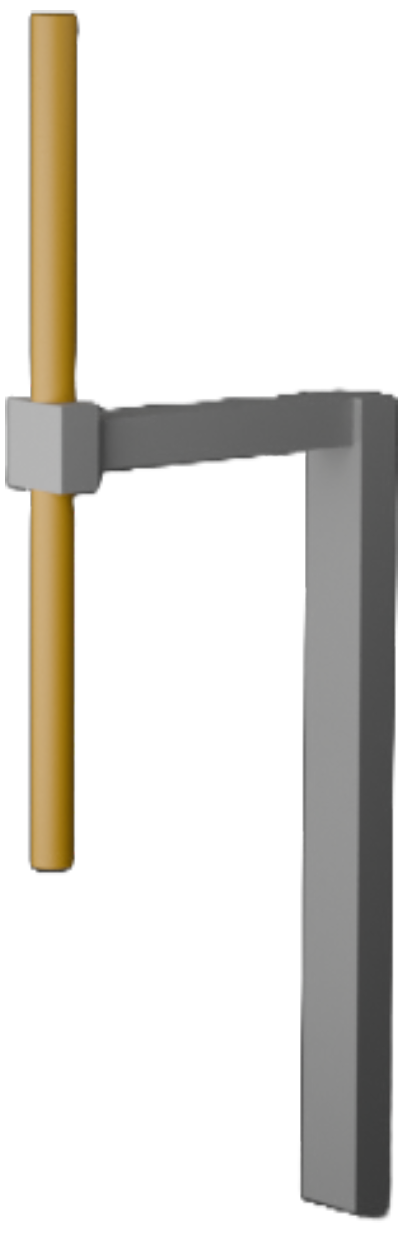


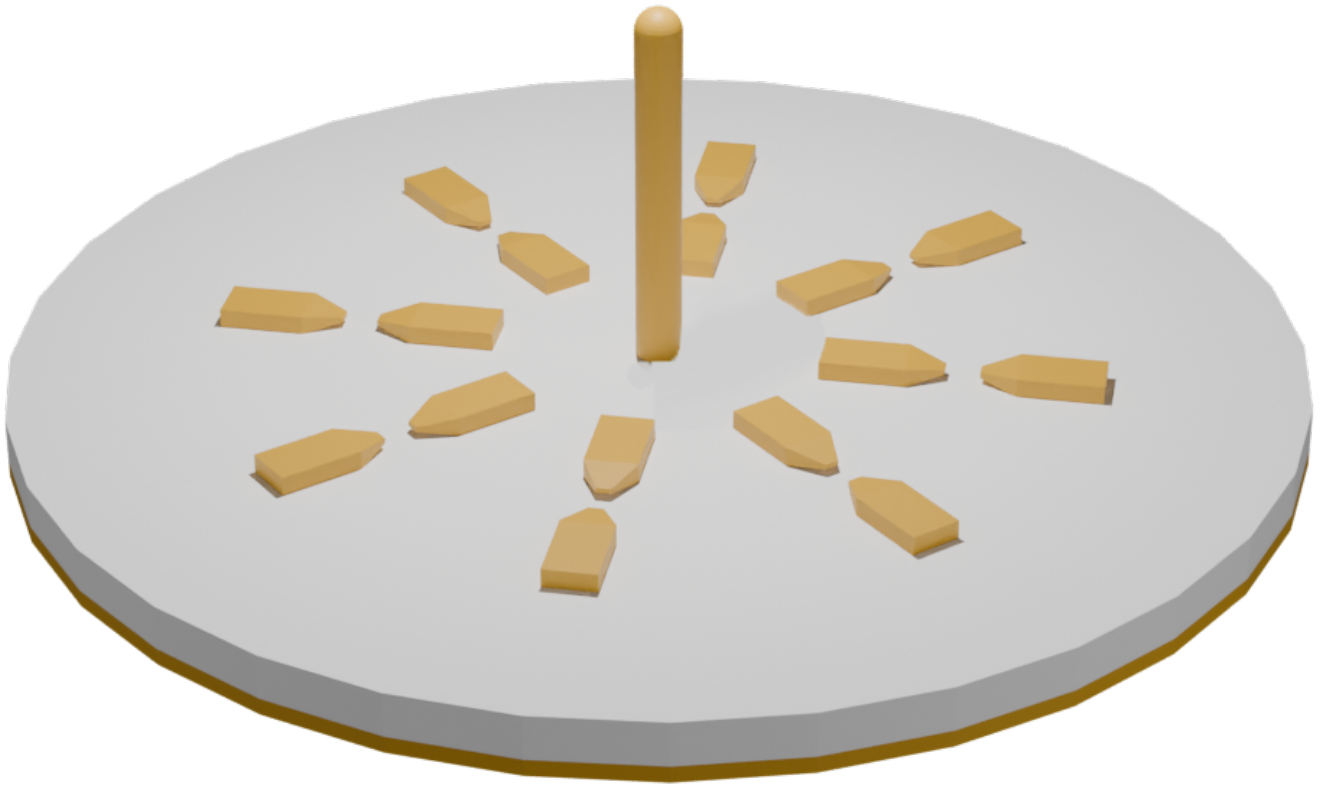
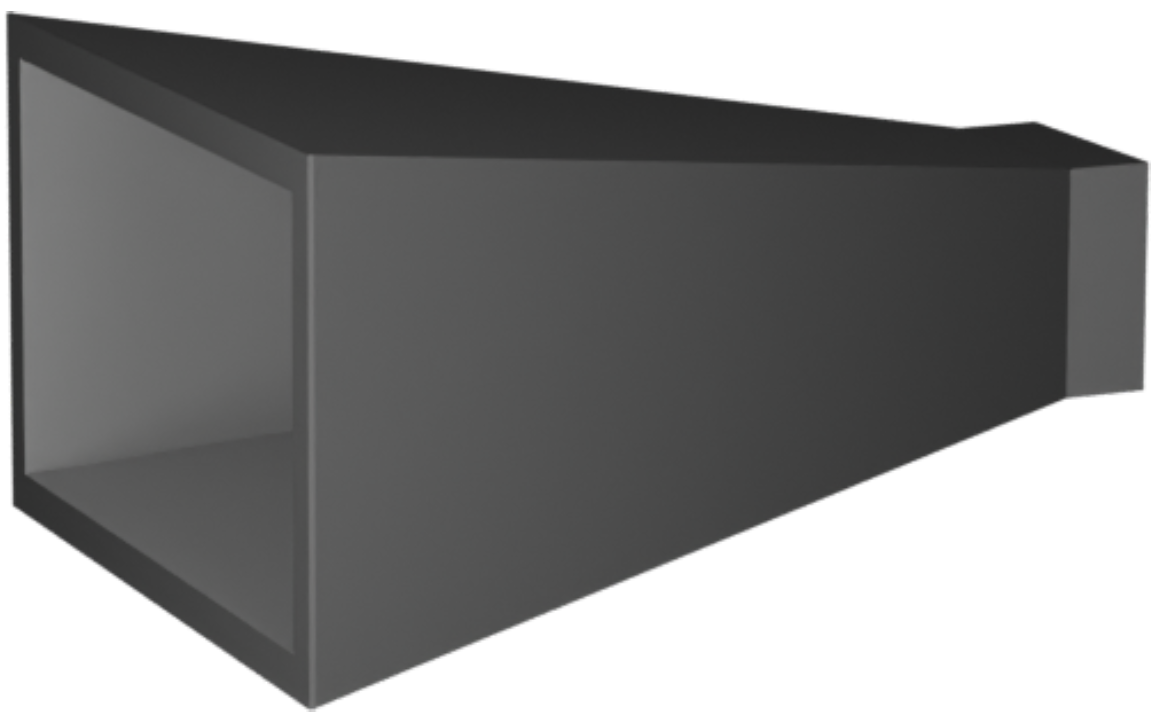
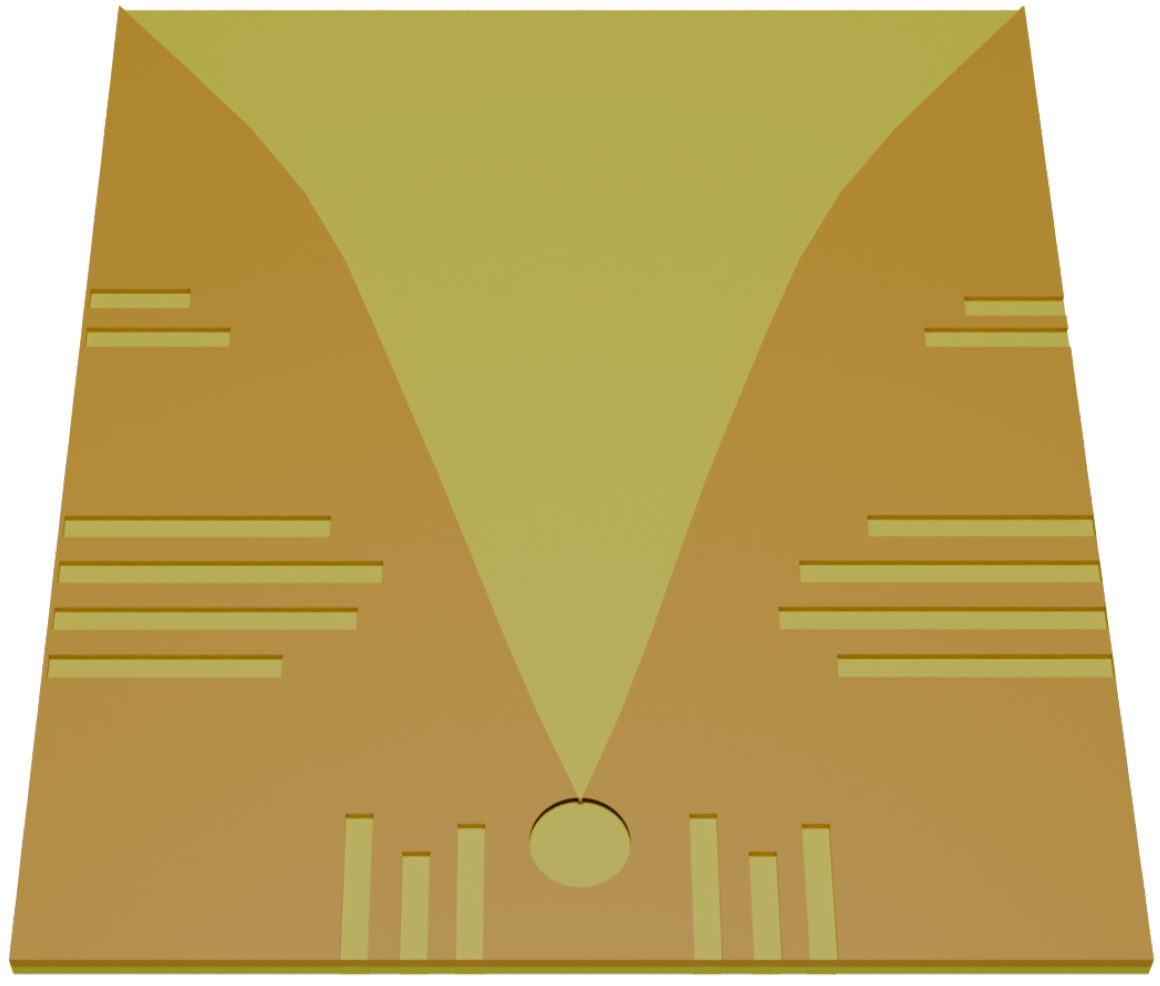
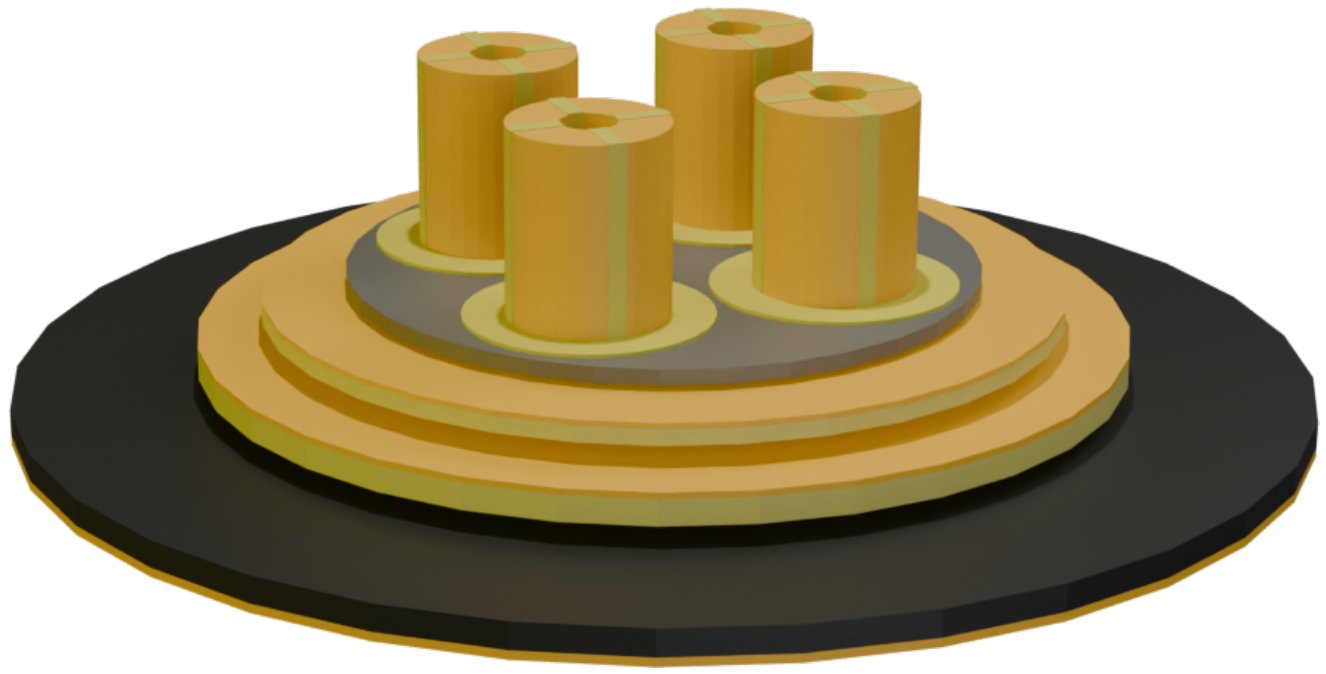
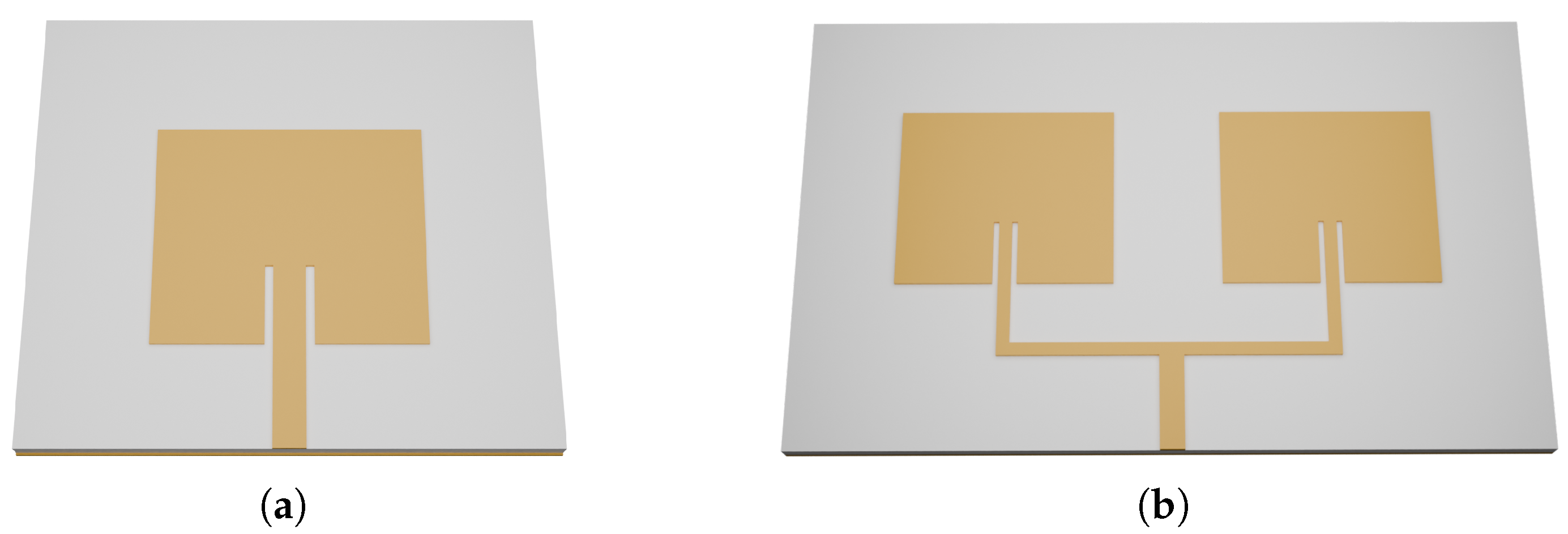
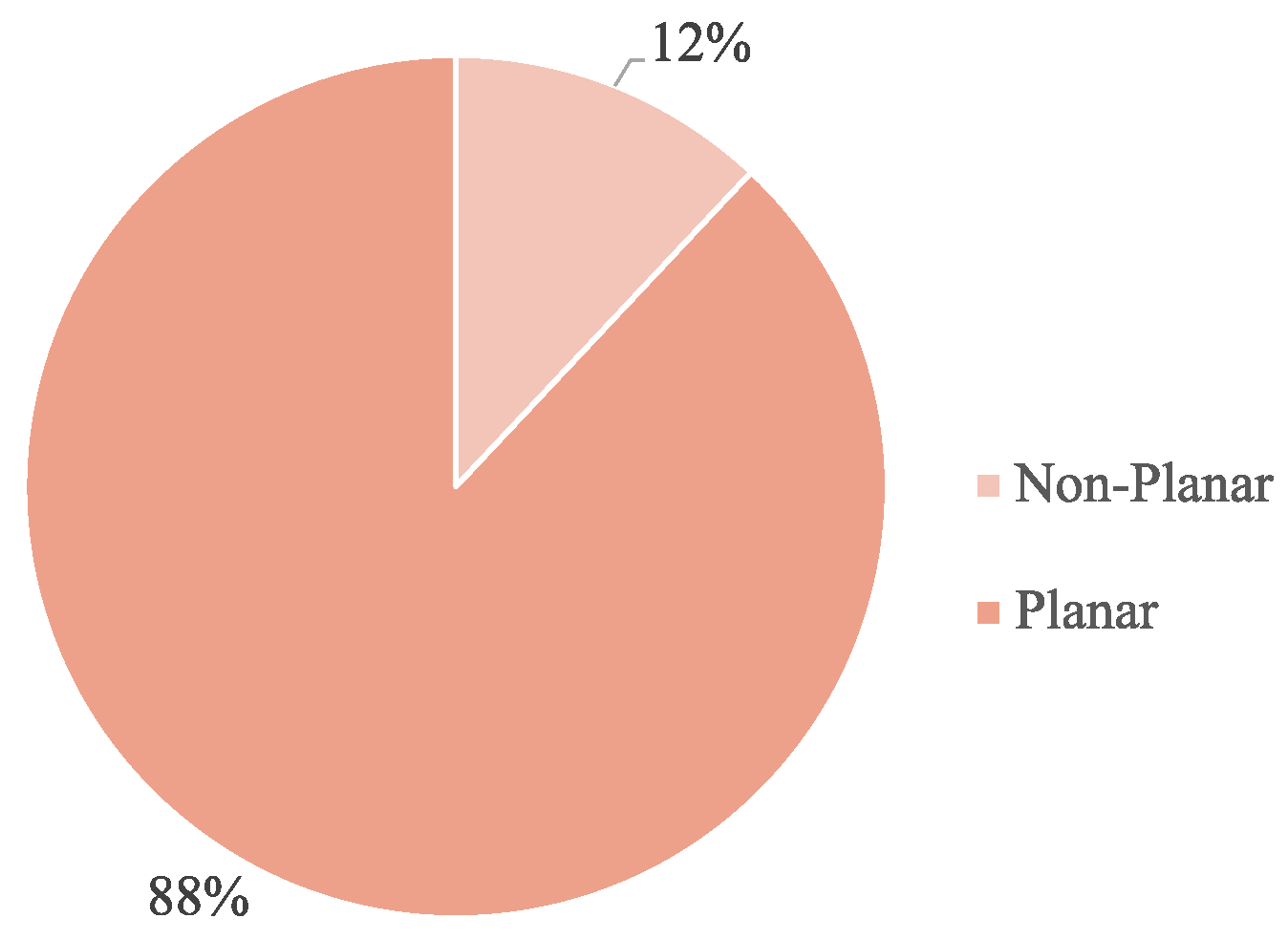
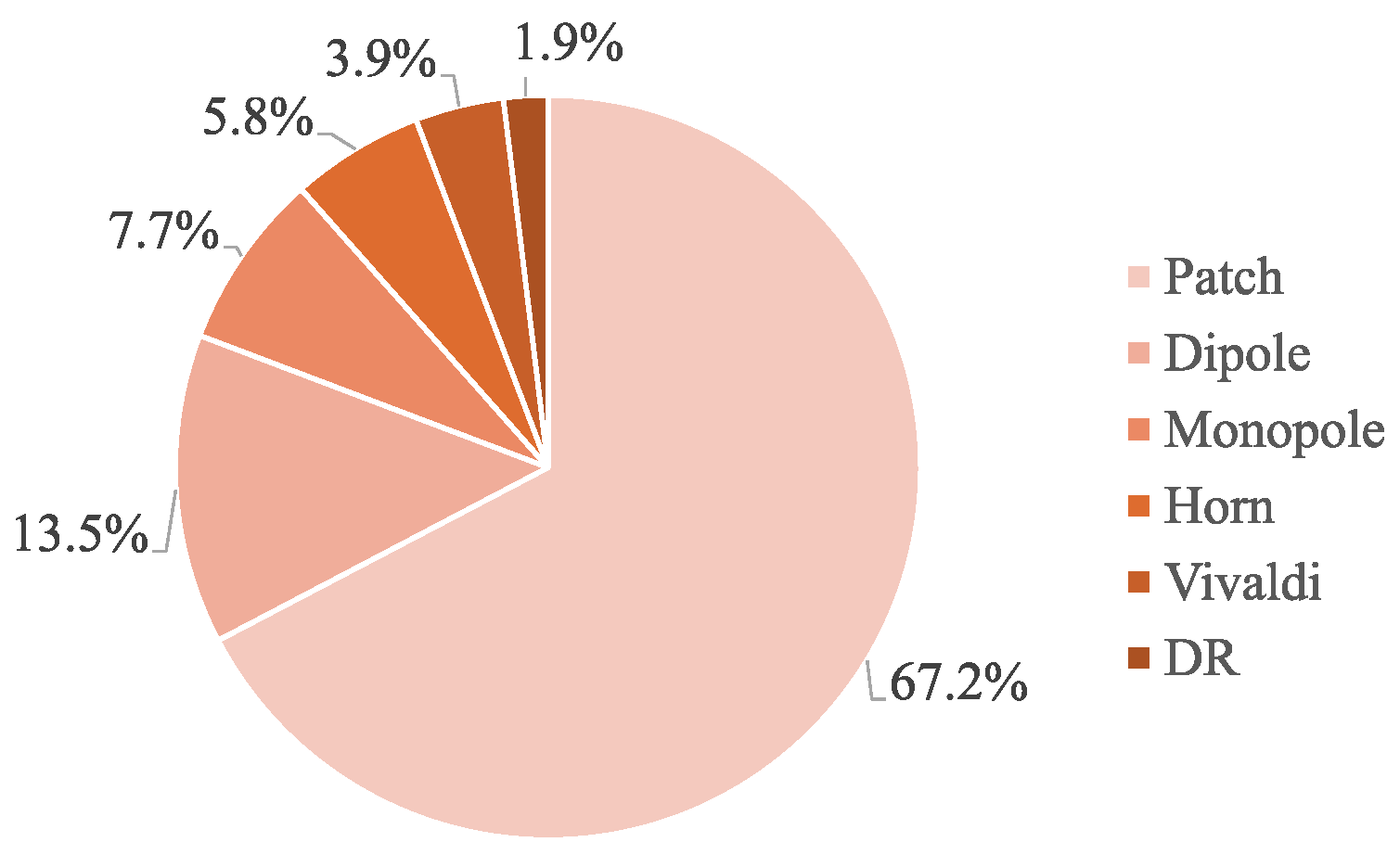
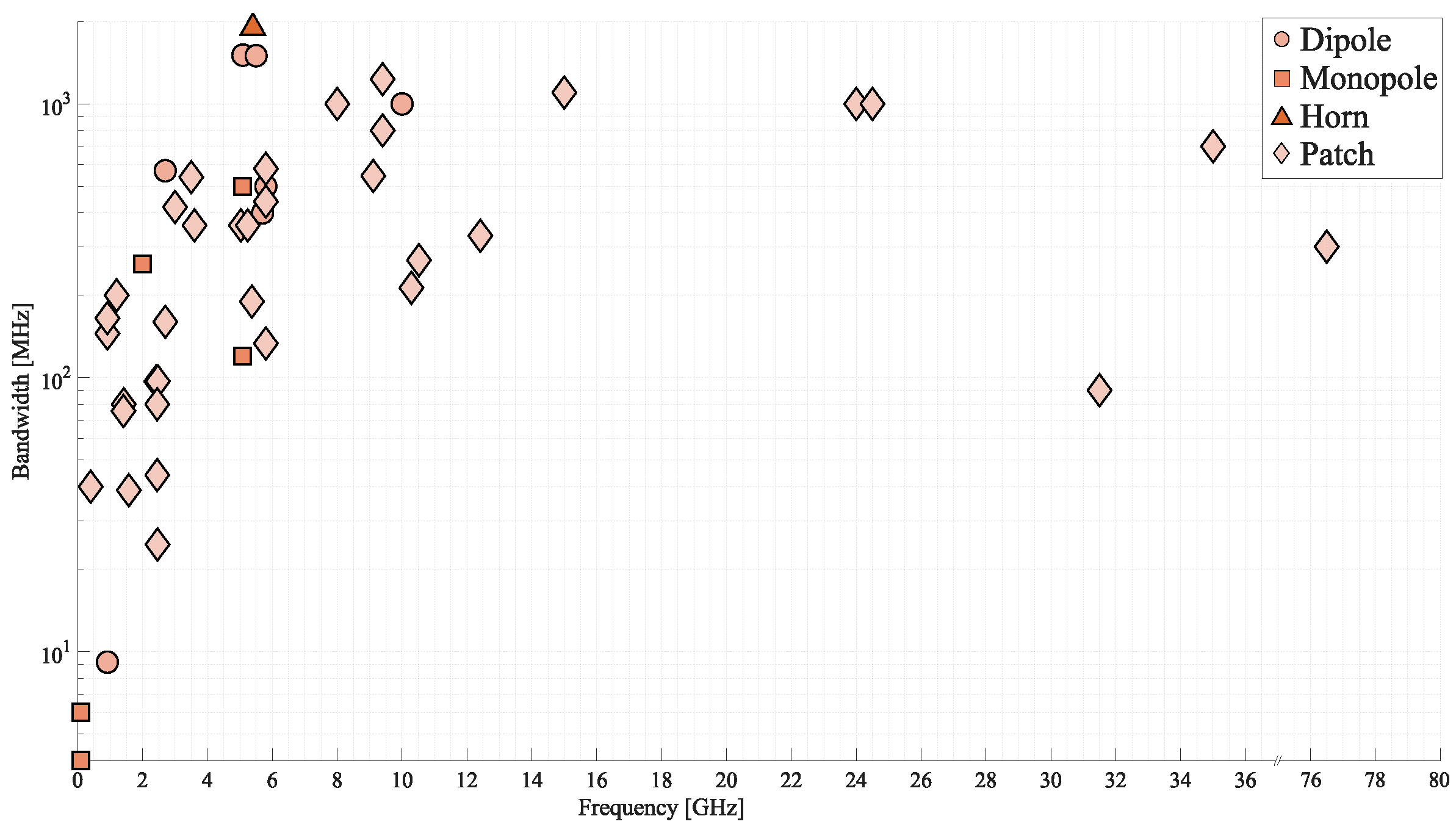
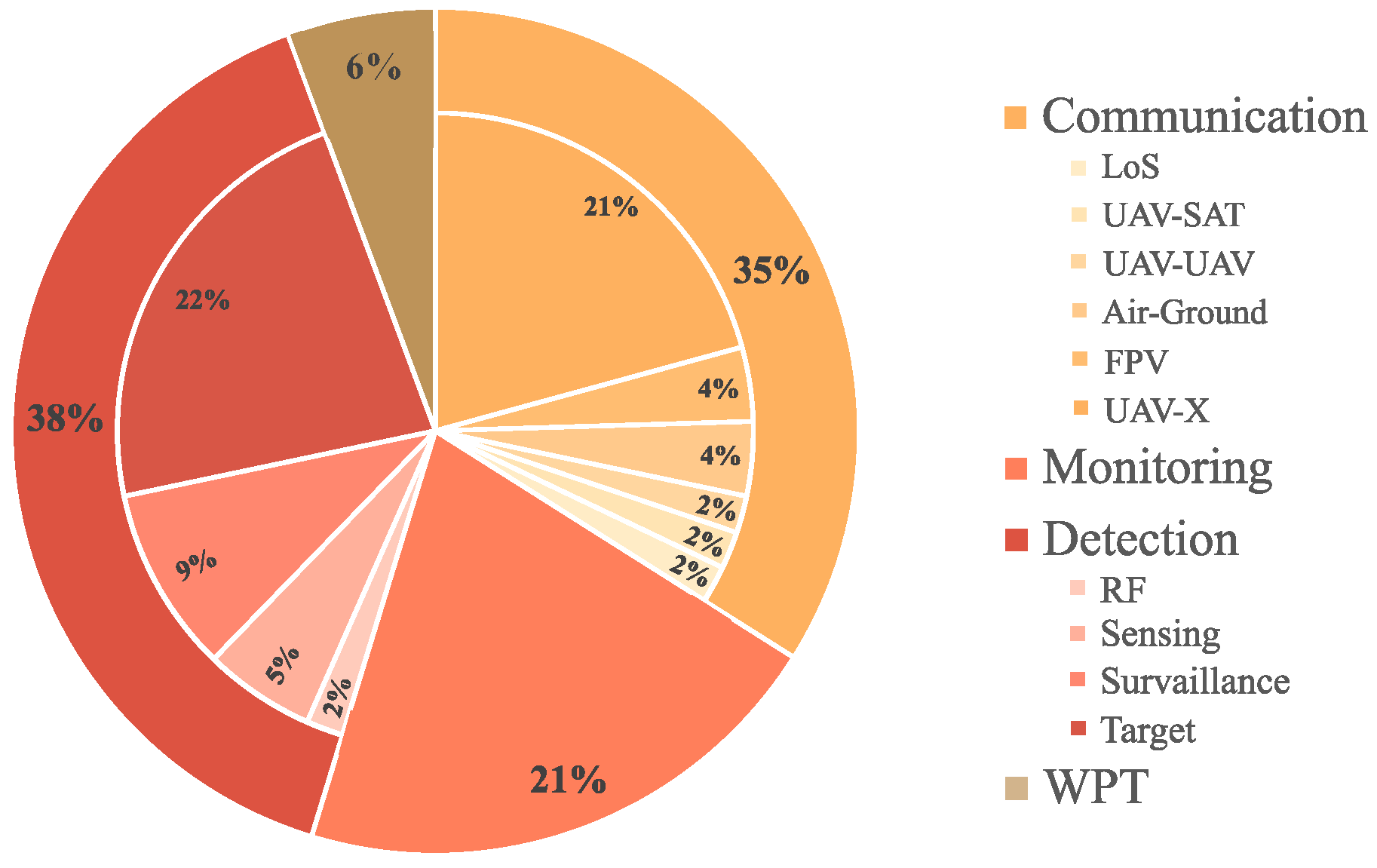
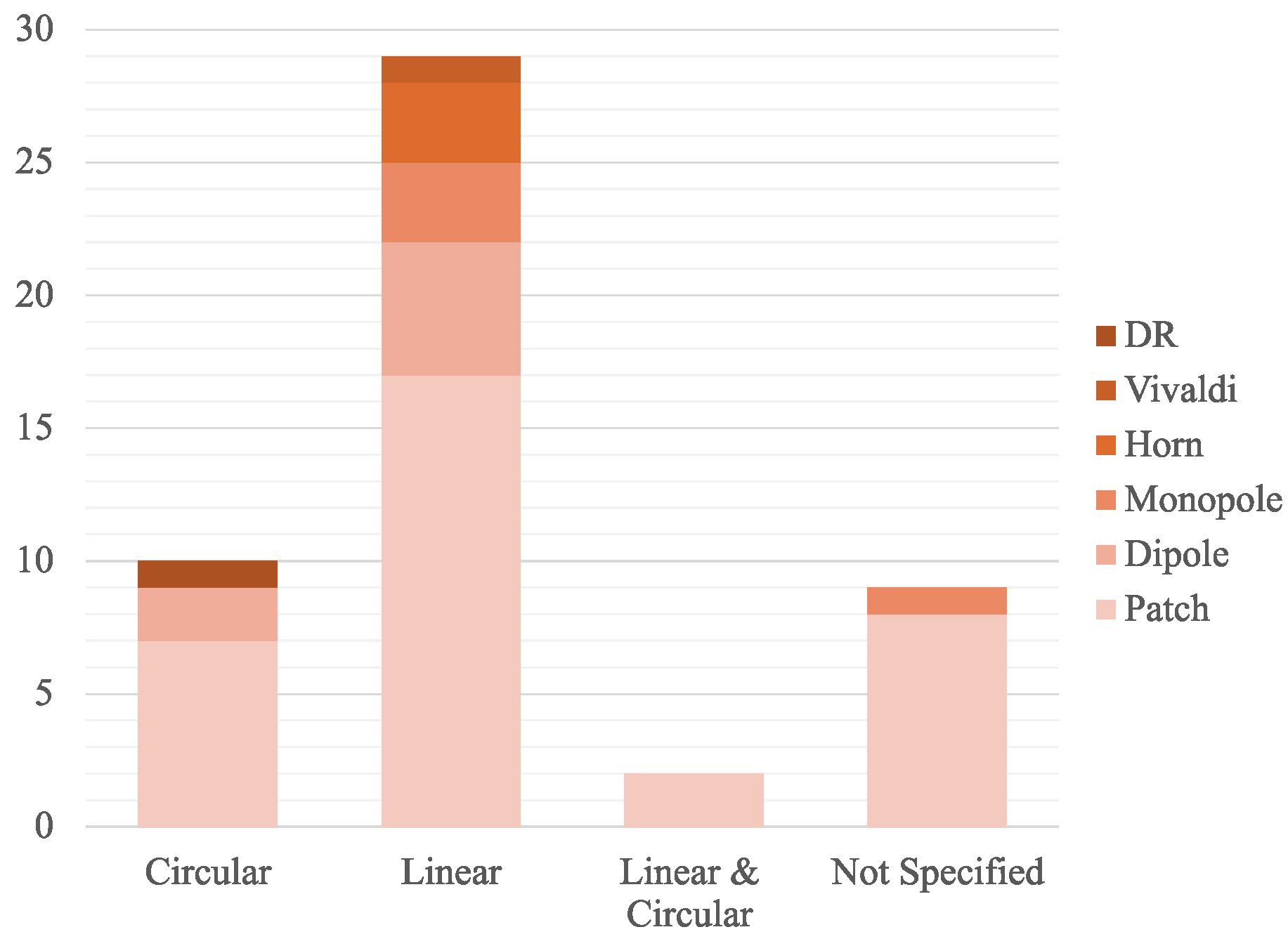

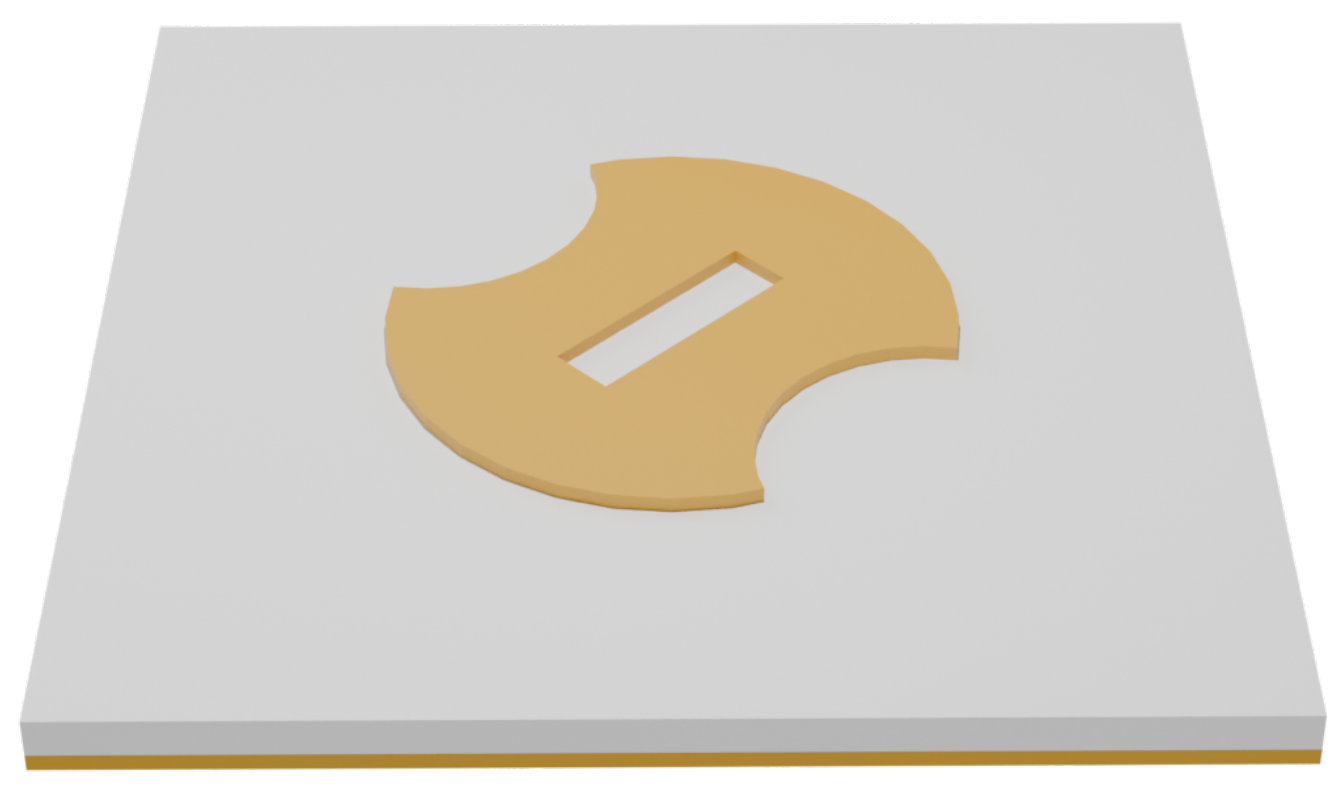

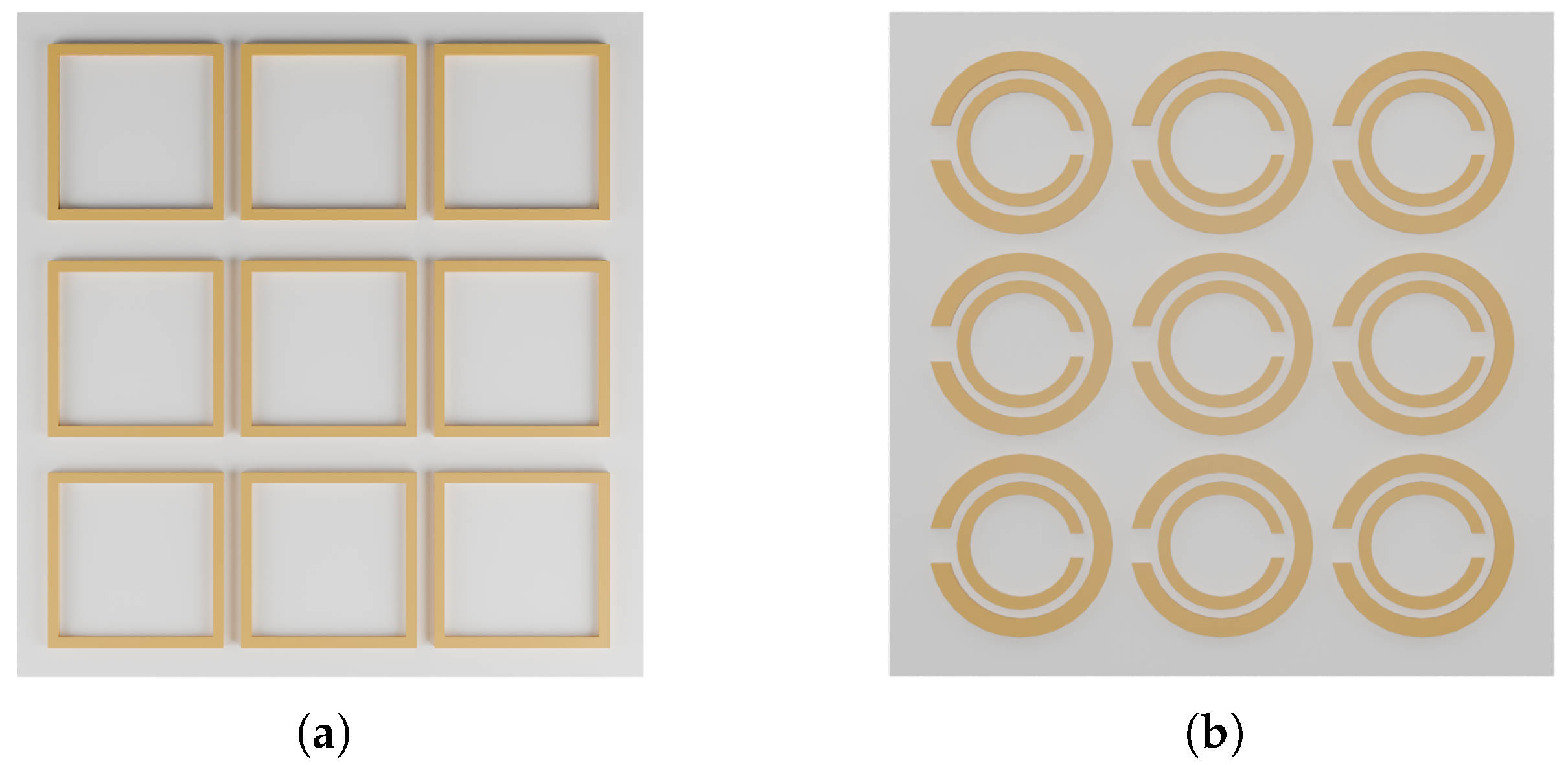
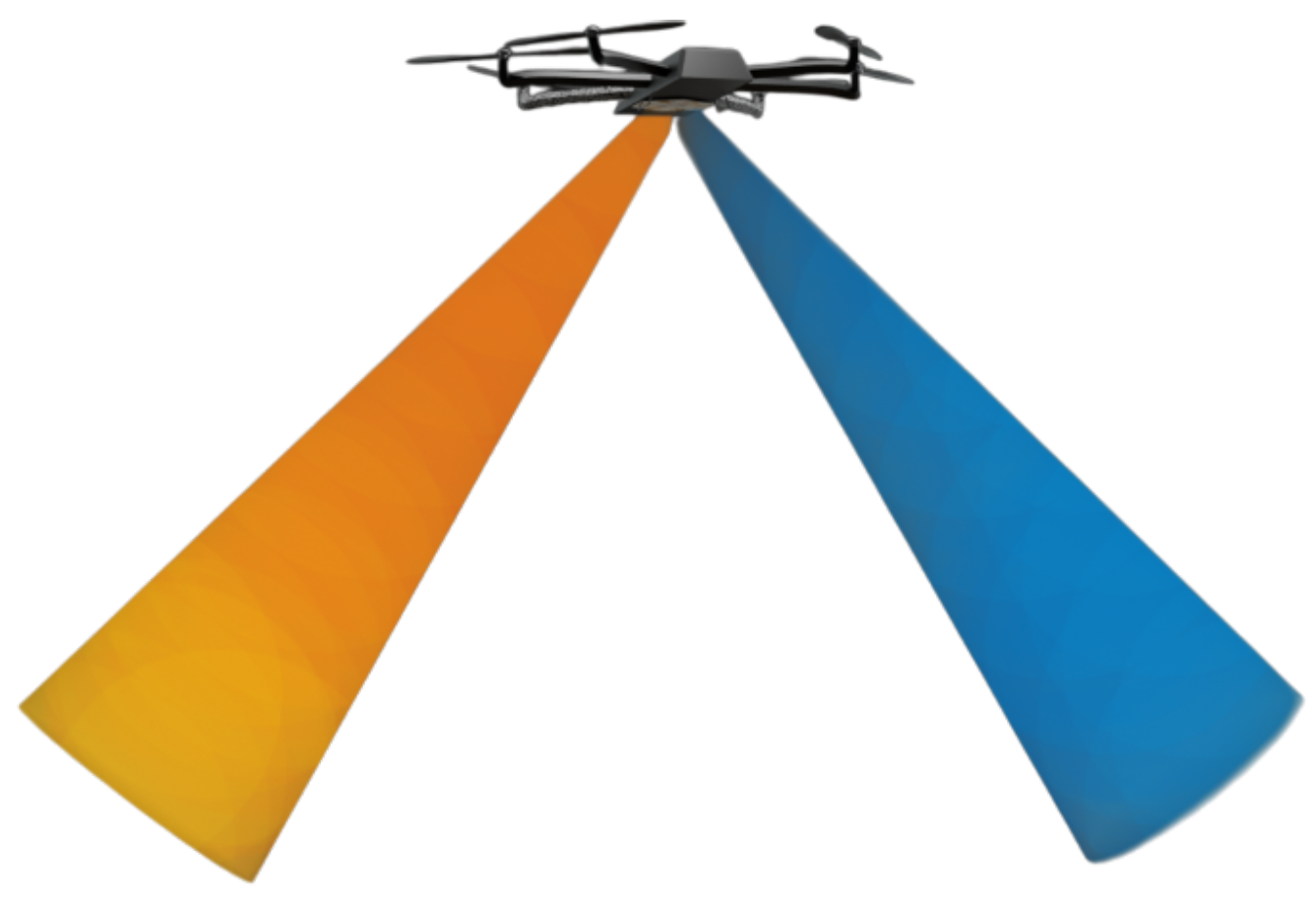

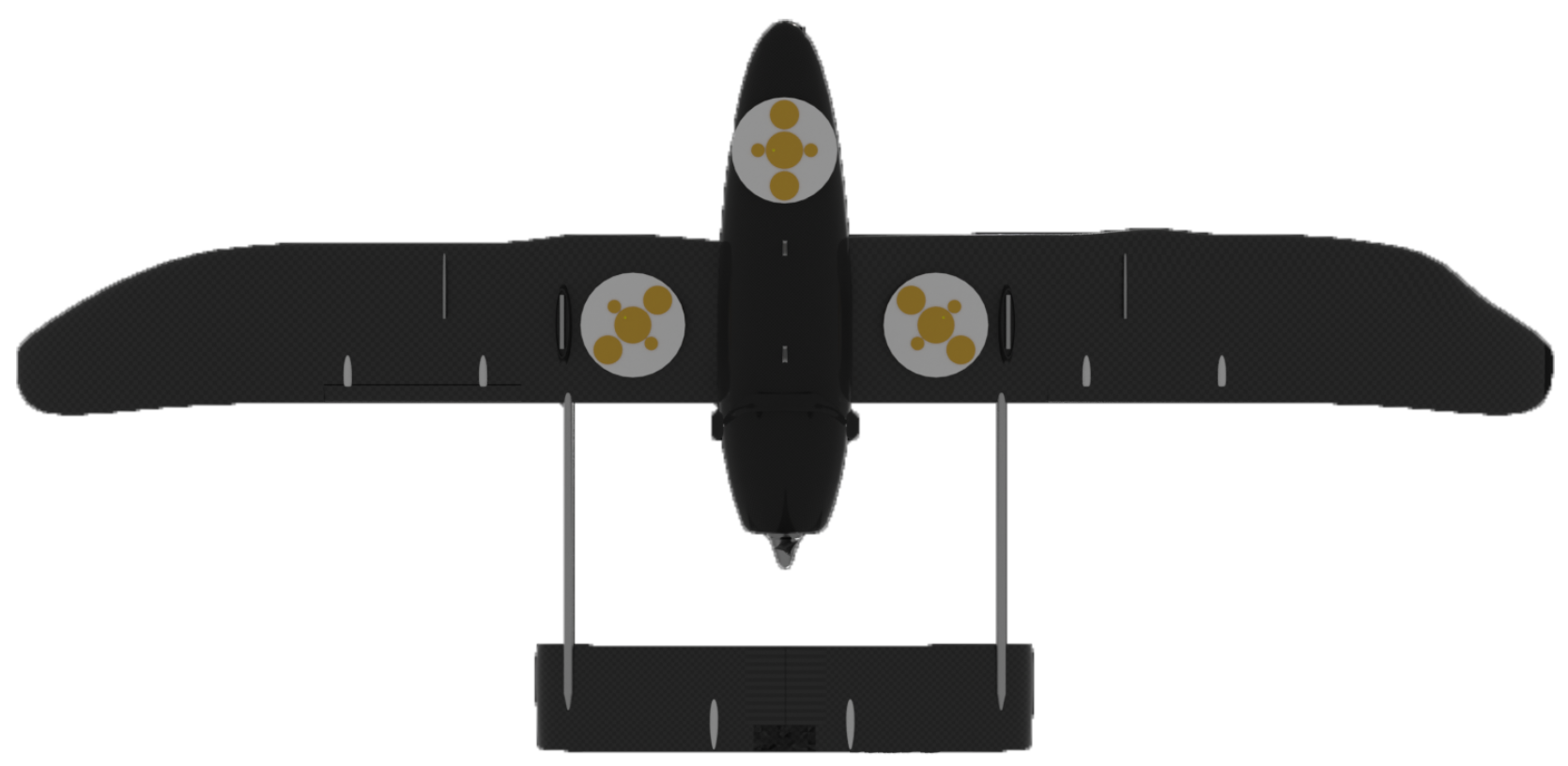
| Ref. | Antenna Type | Antenna Size 1 [mm] | Substrate | Gain [dBi] | Frequency [GHz] | BW 2 [MHz] | Radiation Pattern | Polarization | Application | |
|---|---|---|---|---|---|---|---|---|---|---|
| [10] | Cloverleaf | — 7 | — | 0 | 5.8 | 500 | Omni- Directional | RHCP | FPV Communication | |
| [17] | Crossed Inverted V | Taconic TLX-9 | 2.5 | 6 LHCP: 10.2 RHCP: 9.1 | 5.7 | 400 | Directive | Circular | Air–Ground Communications | |
| [19] | Printed Half Bow-Tie | Taconic RF-60 | 6.15 | 5.9 | 5.09 | 1507 | Directive | Linear | UAV Communications | |
| [20] | Yagi-Uda | IS680-0.5T | 3.5 | Vrt 4: 6.35 Hzt 5: 6.40 | 5.5 | 1500 | Directive | Linear | UAV–UAV Communications | |
| [21] | Circular Folded | Ø: 40 | FR-4 | 4.3 | 1.12 | 0.915 | 9.15 | — | Linear | RF Detection and Communications |
| [22] | Arrow Shape | — × 54 × 24 | Rogers RT5880 and Rogers RO4003C | 2.2 3.38 | 9.5 | 10 | 1000 | Directive | Linear | Target Detection and Surveillence |
| [23] | L-Shaped | — | Polyimide Film | 3.5 | 13.7 | 2.7 | 570 | Directive | Linear | UAV-X 3 Communications |
| Ref. | Antenna Type | Antenna Size 1 [mm] | Substrate | Gain [dBi] | Frequency [GHz] | BW 2 [MHz] | Radiation Pattern | Polarization | Application | |
|---|---|---|---|---|---|---|---|---|---|---|
| [27] | Monopole and Circular Substrate | — 6 | Taconic RF-35 | 3.5 | 4.9 — | 5.09 | 120 | Directive and Omnidirectional | Linear | UAV Communications |
| [28] | Meander Line and Patch | Taconic RF-35 | 3.5 | 5.8 | 5.09 | 500 | Directive | Linear | UAV-X 3 Communications | |
| [29] | Meander Line | FR-4 | 4.4 | — | 0.1 | 6 4 | — | — | EMI 4 Sensing | |
| [30] | Bent Monopole | — | Arlon AD 250C | 2.5 | 5.91 to 7.75 | 2 | 260 | Directive | Linear | SL 5 for Navigation and Surveillance |
| Ref. | Antenna Type | Antenna Size 1 [mm] | Substrate | Gain [dBi] | Frequency [GHz] | BW 2 [MHz] | Radiation Pattern | Polarization | Application | |
|---|---|---|---|---|---|---|---|---|---|---|
| [33] | Horn | CCL 3 FR-4 | — 7 | 15.8 16.25 | 5.4 | 1900 | Directive | Linear | Surface Deformations Monitoring | |
| [34] | Horn | — | CCL FR-4 | — | — | 5.4 | — | Directive | Linear | Landslide Monitoring |
| [35] | Horn | — | — | — | 30 | — | — | Directive | Linear | WPT |
| [39] | Vivaldi | L 4: S 5: | FR-4 | 4.3 | — | 1.8 | 2400 | Directive | Linear | Landmine and IED 6 Detection |
| [8] | DR | : 100 | PREPERM ABS1000 Rogers RO6010 | 8.2 10 | −1 | 1.176 1.575 | — | — | Circular RHCP | UAV Navigation |
| Ref. | Antenna Type | Antenna Size 1 [mm] | Substrate | Gain [dBi] | Frequency [GHz] | BW 2 [MHz] | Radiation Pattern | Polarization | Application | |
|---|---|---|---|---|---|---|---|---|---|---|
| [6] | Patch 3 | Taconic TLY | 2.2 | 6.25 | 2.4 | — 7 | — | Linear | FPV Communication | |
| [44] | Patch | Rogers RO5008 WF 4 | 3.5 | 8-10 | 3 | 420 | Directive | Linear | UAV-SAT 5 Communication and Energy Harvesting | |
| [46] | Patch | Ø: 188 | FR-4 | — | 6 | 0.915 | Linear: 145 Circular: 165 | — | Linear and Circular | RF Sensing |
| [47] | Patch | Rogers RO3003 | 3 | 5.09 | 31.4 | 11,650 | Omni- Directional | — | UAV Communications | |
| [48] | Patch | 5.25 | Rogers RO4003 | 3.55 | 0 1.5 | 2.45 5.8 | 44.1 133.4 | Omni- Directional | Circular | UAV Communications |
| [49] | Patch | Rogers RO4003C | 3.5 | 8.5 | — | 400 | Directive | Linear & Circular | UAV Navigation and Telemetry | |
| [50] | Patch | FR-4 | 4.3 | — | 3.5 | 540 | Directive | Linear | UAV Target Detection | |
| [7] | Patch Array | Rogers RO4830 | 3.2 | 13.8 | — | 16,600 2000 4000 60,000 | Directive | — | UAV-X 6 Communication | |
| [9] | Patch Array | Ø: 152 | Rogers RT Duroid 5880 | 2.2 | 9.55/6.82 & 8.50/7.35 | 2.42/2.47 & 5.03/5.24 | 97 360 | Directive and Quasi-Omni- Directional | Linear | Surveillance Search and Rescue |
| [12] | Patch Array | — | Rogers RT Duroid Family | 2.2 | 13.4 | 35 | 700 | Directive | Linear | WPT |
| [13] | Patch Array | — | Teflon Glass Fiber | 2.15 | 26.65 | 5.8 | 440 | Directive | Circular | Long Distance Wireless Communication |
| [14] | Patch Array | — | — | 13 | 1.42 2.7 | 80 160 | — | Linear | Soil and Temperature Monitoring | |
| [43] | Patch Array | Rogers RT Duroid 5880 | 2.2 | 7.94 10.21 | 10.288 12.412 | 213 330 | Directive | Linear | UAV–Ground Communication | |
| [51] | Patch Array | — | Rogers RT Duroid 5880 | — | ULA: 17.47 URA: 20.38 UCA: 18.88 | 10.52 | 268.7 | Directive | Linear | Surveillance |
| [52] | Patch Array | FR-4 | 4.4 | 20.9 | 8 | 1000 | Directive | Linear | WPT | |
| [53] | Patch Array | NPC-H220 | 2.17 | 21.6 | 9.4 | 1231 | Directive | Circular | Monitoring and Disaster Response | |
| [54] | Patch Array | — | FR-4 | 4.4 | 11.95 | 5.8 | — | Directive | — | UAV Communication |
| [55] | Patch Array | FR-4 | — | 6.39 3.825 | 5.37 9.11 | 189.8 545.8 | Directive | Linear | Vegetation Mapping and Weather Observation |
| Ref. | Antenna Type | Antenna Size 1 [mm] | Substrate | Gain [dBi] | Frequency [GHz] | BW 2 [MHz] | Radiation Pattern | Polarization | Application | |
|---|---|---|---|---|---|---|---|---|---|---|
| [56] | Patch 3 Array | — 9 | Rogers RO4003 | — | 7.5 | 5.8 | — | — | Circular | UAV Navigation and OATR 4 Monitoring |
| [57] | Patch Array | FR-4 | — | — | 1.575 | 38.84 | — | RHCP | GPS Reception with Anti-Jamming | |
| [58] | Patch Array | — | — | — | 11 | 2.45 | 80 | Directive | Circular | Search and Rescue |
| [59] | Patch Array | NPC-H220 | 2.17 | 11.6 | 9.4 | 800 | Directive | LHCP | Environmental and Disaster Monitoring | |
| [60] | Patch Array | — | Rogers TMM 4 | 4.5 | 14.5 | 5.8 | 580 | Directive | — | Monitoring |
| [61] | Patch Array | Ø: 150 | Rogers RO4360G2 | 6.15 | — | 2.46 | <24.6 | — | Linear | Precise Vertical Landing |
| [62] | Patch Array | Rogers RT Duroid 5880 | 2.2 | 17.9 | 15 | 1100 | Directive | Linear | LoS 5 Communication | |
| [63] | Patch Array | — | — | — | 7.7 12.8 16.3 | 0.4 1.2 3.6 | 40 200 360 | Directive | Linear | Object Detection |
| [64] | Patch Array | — | FR-4 | — | 11.69 | 24 | 1000 | Directive | Linear | Detection and Collision Avoidance |
| [65] | Patch Array | — | Rogers RO4835 and FR-4 | 3.66 — | — | 78.11 | 4770 | Directive | — | Radar and UAV Obstacle Avoidance |
| [66] | Patch Array | EMC and Cu 6 | — | >11 | 77 | 2400 | — | — | Autonomous Vehicle and Sensing | |
| [67] | Patch Array | Rogers RO4350B | 3.66 | 25.05 | 24.5 | >1000 | Directive | Linear | UAV Obstacle Avoidance | |
| [68] | Patch Array | Rogers RT Duroid 5880 | 2.2 | Rx 7: 17.3 Tx 8: 19.4 | — | 400 | Directive | Linear | Detection and Surveillance | |
| [69] | Patch Array | Rogers RO3003 | 3 | 15.3 | — | 4000 | Directive | Linear | UAV Obstacle Avoidance | |
| [70] | Patch Array | — | — | — | 14.337 12.47 | 1.41 31.5 | 75.6 90 | — | — | Soil and Sea Monitoring |
| [71] | Patch Array | Rogers 3003 | — | 12.9 | 77 | 300 | — | — | UAV Formation Flight and Obstacle Avoidance |
| Ref. | Antenna Type | Weight [g] |
|---|---|---|
| [14] | Patch | <1000 1 |
| [28] | Meander Line and Patch | 19.2 |
| [53] | Patch | 66 |
| [44] | Patch | 435 |
| [33] | Horn | ≈495 2 |
| [34] | Horn | ≈495 2 |
| [39] | Vivaldi | Larger: 150 Smaller: 130 |
| (a) | ||
| Ref. | Tested Inside | Tested Outside |
| [17] | Yes | Yes |
| [19] | Yes | — 1 |
| [20] | — | — |
| [10] | — | — |
| [23] | — | — |
| [27] | Yes | — |
| [30] | Yes | — |
| [34] | Yes | Yes |
| [33] | Yes | — |
| [8] | Yes | Yes |
| [39] | Yes | Yes |
| [6] | — | — |
| [44] | Yes | — |
| [46] | — | — |
| [49] | Yes | — |
| [65] | — | — |
| [54] | — | — |
| [43] | — | — |
| (b) | ||
| Ref. | Tested Inside | Tested Outside |
| [62] | — | — |
| [55] | — | — |
| [57] | — | — |
| [67] | Yes | — |
| [60] | — | Yes |
| [68] | Yes | — |
| [61] | — | Yes |
| [9] | Yes | Yes |
| [53] | Yes | — |
| [70] | — | Yes |
| [71] | — | — |
| [59] | Yes | — |
| [66] | — | — |
| [14] | — | Yes |
| [52] | Yes | — |
| [7] | Yes | — |
| [64] | — | Yes |
| Technique Type | Ref. | Technique | Reported Benefits |
|---|---|---|---|
| Structural | [28,29] | Meander lines | Reduces antenna size. |
| [47,51] | Fractal geometries | Reduces antenna size while maintaining electromagnetic properties. | |
| [13,30,43,52,53,54,55,56,57,58,59] | Slots in radiating element | Modifies electromagnetic properties and, as a secondary effect, reduces physical size. Improves bandwidth, radiation patterns, and gain; enables dual-band operation; and generates circular polarization. Reduces physical size. | |
| [7,8,13] | Slots/slits in ground plane | Improves gain and bandwidth, optimizes power distribution within the antenna, and assists in achieving circular polarization. | |
| Material-Based | [8,11,19,60,61] | High-dielectric substrates | Reduces resonant frequency, enabling compact antenna design. Contributes to aerodynamic drag reduction and lighter weight. |
| [11,14,44,48,53,59,60,62,63,64,65] | Vertical stacking | Improves gain and bandwidth, supports multiband operation, avoids interference between frequency bands, enables circular polarization and dual-band operation, suppresses sidelobes, improves signal quality, reduces interference by separating high and low frequency signals, and allows compact integration. | |
| Metasurfaces | [7] | Coffee bean-shaped metasurface | Improves gain and radiation efficiency and reduces losses. |
| [23] | Frequency Selective Surface (FSS) | Improves gain and enhances beamforming by reducing main lobe beamwidth. | |
| [49] | Metasurfaces with unequal spacing | Optimizes circular polarization and bandwidth. |
Disclaimer/Publisher’s Note: The statements, opinions and data contained in all publications are solely those of the individual author(s) and contributor(s) and not of MDPI and/or the editor(s). MDPI and/or the editor(s) disclaim responsibility for any injury to people or property resulting from any ideas, methods, instructions or products referred to in the content. |
© 2025 by the authors. Licensee MDPI, Basel, Switzerland. This article is an open access article distributed under the terms and conditions of the Creative Commons Attribution (CC BY) license (https://creativecommons.org/licenses/by/4.0/).
Share and Cite
Reis, S.; Silva, F.; Albuquerque, D.; Pinho, P. General Overview of Antennas for Unmanned Aerial Vehicles: A Review. Electronics 2025, 14, 3205. https://doi.org/10.3390/electronics14163205
Reis S, Silva F, Albuquerque D, Pinho P. General Overview of Antennas for Unmanned Aerial Vehicles: A Review. Electronics. 2025; 14(16):3205. https://doi.org/10.3390/electronics14163205
Chicago/Turabian StyleReis, Sara, Fábio Silva, Daniel Albuquerque, and Pedro Pinho. 2025. "General Overview of Antennas for Unmanned Aerial Vehicles: A Review" Electronics 14, no. 16: 3205. https://doi.org/10.3390/electronics14163205
APA StyleReis, S., Silva, F., Albuquerque, D., & Pinho, P. (2025). General Overview of Antennas for Unmanned Aerial Vehicles: A Review. Electronics, 14(16), 3205. https://doi.org/10.3390/electronics14163205








